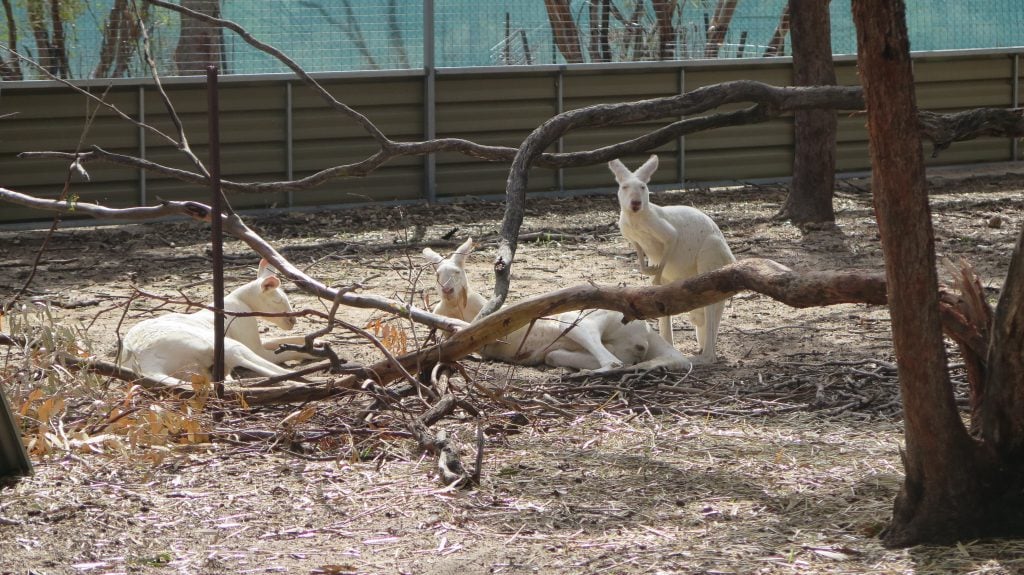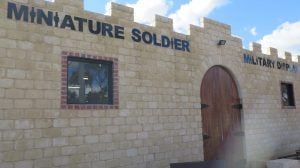17 May 2014
Entry to Mulka’s Cave near Hyden
On our second day in Hyden we had the opportunity to discover more about this wheatbelt town. Firstly we discovered that there are two supermarkets in town, not sure how they survive, but both were well stocked, some prices higher than we pay at home. Opposite the main street is an avenue of metal caricatures depicting life in Hyden and some of its past residents The creation of the avenue is part of a government stimulus package to boost tourism an is quite unique and comical.
Some of the metal caricatures beside the main street of Hyden
We had purchased a gold ticket to go through four of the exhibitions at Wave Rock, and started with the Wildlife Park. I feel sadness at seeing caged animals but they seem well cared for, and there is a breeding program. The Park is set in three hectares of natural bushland, and there are white, grey, red and silver kangaroos and wallabies, koalas, golden possums, donkeys, alpaca, wombats, camels and emus.
Nearly all of the animals in the Park were born in their own natural and comfortable environments, and there are also a number of rare and endangered birds living there. By breeding the animals it is hoped to help save them from extinction and also preserve the wild populations. There was a small mob of white kangaroos and some golden possums, animals I had not seen before. The large collection of birds and poultry is interesting, particularly the gaily coloured parrots.
The white kangaroos resting in the sun (above) and the wombat (below left) and emu (below right)
The Lace Place is situated inside the same building as the Wildlife Park and Wildflowers Cafe. It is a museum especially built to house the collection of Margaret Blackburn of Perth who was keenly interested in history and lace. She added inherited family pieces to her own collection from Australia and overseas and her Order of Australia Medal was awarded for service to Commercial Education. The Blackburn Collection, offered as a bequest to the Western Australian Museum, was later purchased by the Mouritz family of Hyden and the Lace Place was officially opened on June 29 1993 by His Excellency, the Governor of Western Australia, Sir Francis Burt.
Interesting changes in wedding gowns over the years
The Tin Soldiers Museum contained thousands of tin soldiers collected over many years, with interesting posters of front pages of newspapers during the war, a model railway and other memorabilia from days gone by.
The Pioneer Museum exhibited thousands of items of memorabilia from the early 1920s onwards, a real step back in history!
Our last stop for the day was to The Humps and Mulka’s Cave. The rock in which the cave has developed is a medium to coare grained porphyritic granite which originated 2,800 million years ago under intense heat and pressure many kilometres below the earth’s surface. Erosion over the intervening period has exposed the rock in the form of a monolith. Mulka’s Cave is in a large block of rock that has slipped from the main granite outcrop known as The Humps. The lower surface of the block has been hollowed out by chemical weathering and by wind erosion to form the cave as it is today.
The dominant art in Mulka’s Cave is hand stencils, of which there are over 140 examples representing both adults and children. Stencils are made by placing the hand on the rock then blowing over it with pigment, when the hand is removed, a negative impression remains The reasons for making hand stencils are many, but principally they are a form of signature left by those who had rights to the area There are also some linear paintings which are often outlined with the finger or with a fibrous twig dipped in crushed ochre mixed with water.
Hand stencils (left) and linear paintings (right) in Mulka’s Cave
Needless to say, by this time we were getting tired, so we headed back to the hotel for a nap before dinner. The process for dinner was the same as last night, choose your own meat/chicken, cook it yourself and help yourself to vegetables or salad. It is a bit different and fun, and the meal was very nice.
An early start tomorrow a we drive about 350 kilometres back to the west coast and Bunbury where we will spend about four days exploring the south western corner.
















